The Cambridge History of China. Vol. 06. Alien Regimes and Border States, 907-1368
Подождите немного. Документ загружается.


KHUBILAI AND RELIGION 463
served the great khan Mongke.
8
' But Khubilai made a concerted effort to
invite and recruit foreign Christians.
Marco Polo was the most renowned Christian in the exchanges between
East and West in Khubilai's time.
82
The Venetian traveler, whose book was
to be the sole source of information for Europeans on China for many years to
come, reputedly reached China in 1275.
83
Marco tells us that his father and
uncle, Nicolo and Maffeo Polo, preceded him to China. The two merchants
had left Venice in 1252, had engaged in trade in Constantinople for some
years,
and had traveled in Russia and Central Asia until they reached
Khubilai's court in late 1265 or early 1266. According to Marco, Khubilai
"beamed with the greatest kindness" and "received them with great honour
and makes them great joy and very great festival."
8
t After some polite
conversation, Khubilai made his request: He asked the Polos to persuade the
pope to send one hundred learned Christians with them when they returned
to China. They could, he claimed, help convert his subjects to Christianity.
Yet his principal motive in making this request was to attract learned men to
help him administer his domains in China. With his eclectic attitude toward
religion, Khubilai was not particularly eager for conversions to Christianity
among his own people. But he needed to persuade the Polos and the Chris-
tian hierarchy that he wanted the learned Europeans to help in guiding his
peoples to Christianity.
When the Polos returned to the Christian world in 1269, they faced
disappointments. They soon learned that Pope Clement IV had died in the
previous year, impeding their plans to fulfill Khubilai's request and to return
81 See the charming book by Leonardo Olschki, Guillaumt
Boucher:
A
French
artist at the
court
of the
khans
(Baltimore, 1946).
82 Herbert Franke, "Sino-Western contacts under the Mongol empire," p. 54. The literature on Marco
Polo and his book is voluminous. The best translation is the work by Arthur C. Moule and Paul
Pelliot, Marco
Polo:
The
description
of the world; also useful is Henry Yule's
The book
ofSer
Marco
Polo,
3rd
ed.,
rev. by Henri Cordier (London, 1903). This edition was supplemented by Henri Cordier in Ser
Marco
Polo:
Notes
and addenda to Sir Henry
Yule's
edition,
containing
the
results
of
recent research
and discovery
(London, 1920). The finest study of Polo's book is Leonardo Olschki's Marco
Polo's
Asia (Berkeley and
Los Angeles, i960).
83 Some scholars have speculated that Marco Polo may never have reached China and that some of the
incidents he recounts were derived from conversations that he had with Persian or Arab merchants or
travelers. See, for example, John W. Haeger, "Marco Polo in China? Problems with internal evi-
dence," Bulletin of
Sung
and Yuan Studies, 14 (1978), pp. 22—30. Marco's own words give rise to these
doubts. He claims, for example, to have assisted the Mongols in their siege of the Sung stronghold at
Hsiang-yang, but that battle ended in 1273,
tw0
years before he allegedly arrived in China. There are
other discrepancies as well as obvious exaggerations and some curious omissions in his accounts. These
doubts, however, are far from conclusive, as Herbert Franke concluded in his "Sino-Western contacts
under the Mongol empire," p. 54. See also Francis W. Cleaves, "A Chinese source bearing on Marco
Polo's departure from China and a Persian source on his arrival in Persia," Harvard Journal of Asiatic
Studies, 36 (1976), pp. 181-203. Recently such doubts were laid permanently to rest by Yang Chih-
chiu,
who in his Yuan shih san lun (Peking, 198;), pp. 97—132, produced conclusive proof of Marco
Polo's presence in China during Khubilai's reign.
84 Moule and Pelliot, Marco Polo, vol. 1, p. 77.
Cambridge Histories Online © Cambridge University Press, 2008
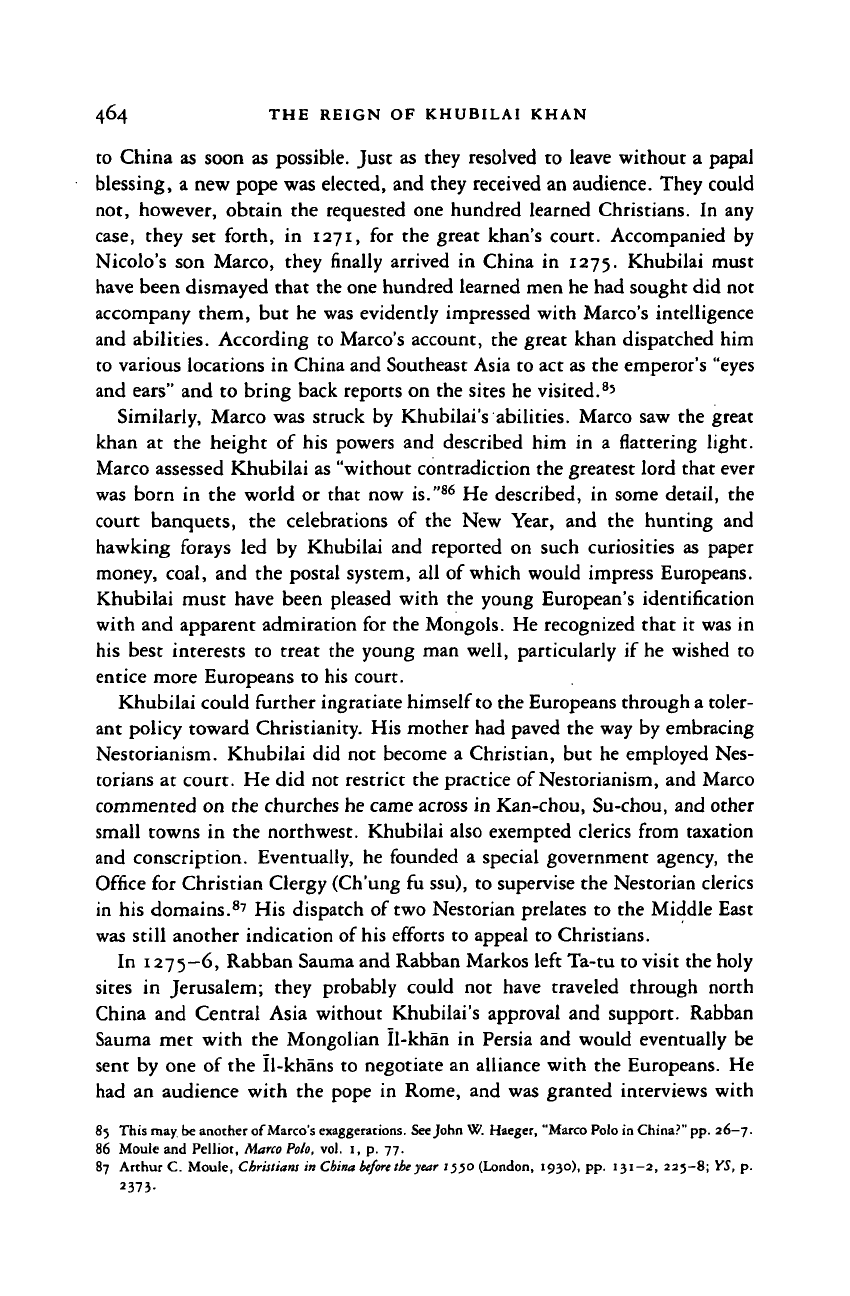
464 THE REIGN OF KHUBILAI KHAN
to China as soon as possible. Just as they resolved to leave without a papal
blessing, a new pope was elected, and they received an audience. They could
not, however, obtain the requested one hundred learned Christians. In any
case,
they set forth, in 1271, for the great khan's court. Accompanied by
Nicolo's son Marco, they finally arrived in China in 1275. Khubilai must
have been dismayed that the one hundred learned men he had sought did not
accompany them, but he was evidently impressed with Marco's intelligence
and abilities. According to Marco's account, the great khan dispatched him
to various locations in China and Southeast Asia to act as the emperor's "eyes
and ears" and to bring back reports on the sites he visited.
85
Similarly, Marco was struck by Khubilai's abilities. Marco saw the great
khan at the height of his powers and described him in a flattering light.
Marco assessed Khubilai as "without contradiction the greatest lord that ever
was born in the world or that now
is."
86
He described, in some detail, the
court banquets, the celebrations of the New Year, and the hunting and
hawking forays led by Khubilai and reported on such curiosities as paper
money, coal, and the postal system, all of which would impress Europeans.
Khubilai must have been pleased with the young European's identification
with and apparent admiration for the Mongols. He recognized that it was in
his best interests to treat the young man well, particularly if he wished to
entice more Europeans to his court.
Khubilai could further ingratiate himself
to
the Europeans through a toler-
ant policy toward Christianity. His mother had paved the way by embracing
Nestorianism. Khubilai did not become a Christian, but he employed Nes-
torians at court. He did not restrict the practice of Nestorianism, and Marco
commented on the churches he came across in Kan-chou, Su-chou, and other
small towns in the northwest. Khubilai also exempted clerics from taxation
and conscription. Eventually, he founded a special government agency, the
Office for Christian Clergy (Ch'ung fu ssu), to supervise the Nestorian clerics
in his domains.
87
His dispatch of two Nestorian prelates to the Middle East
was still another indication of
his
efforts to appeal to Christians.
In 1275-6, Rabban Sauma and Rabban Markos left Ta-tu to visit the holy
sites in Jerusalem; they probably could not have traveled through north
China and Central Asia without Khubilai's approval and support. Rabban
Sauma met with the Mongolian Il-khan in Persia and would eventually be
sent by one of the Il-khans to negotiate an alliance with the Europeans. He
had an audience with the pope in Rome, and was granted interviews with
85 This may be another of Marco's exaggerations. See John W. Haeger, "Marco Polo in
China?"
pp. 26-7.
86 Moule and Pelliot, Marco Polo, vol. 1, p. 77.
87 Arthur C. Moule, Christians in China
before the
year 1550 (London, 1930), pp. 131-2, 225-8; YS, p.
2373-
Cambridge Histories Online © Cambridge University Press, 2008
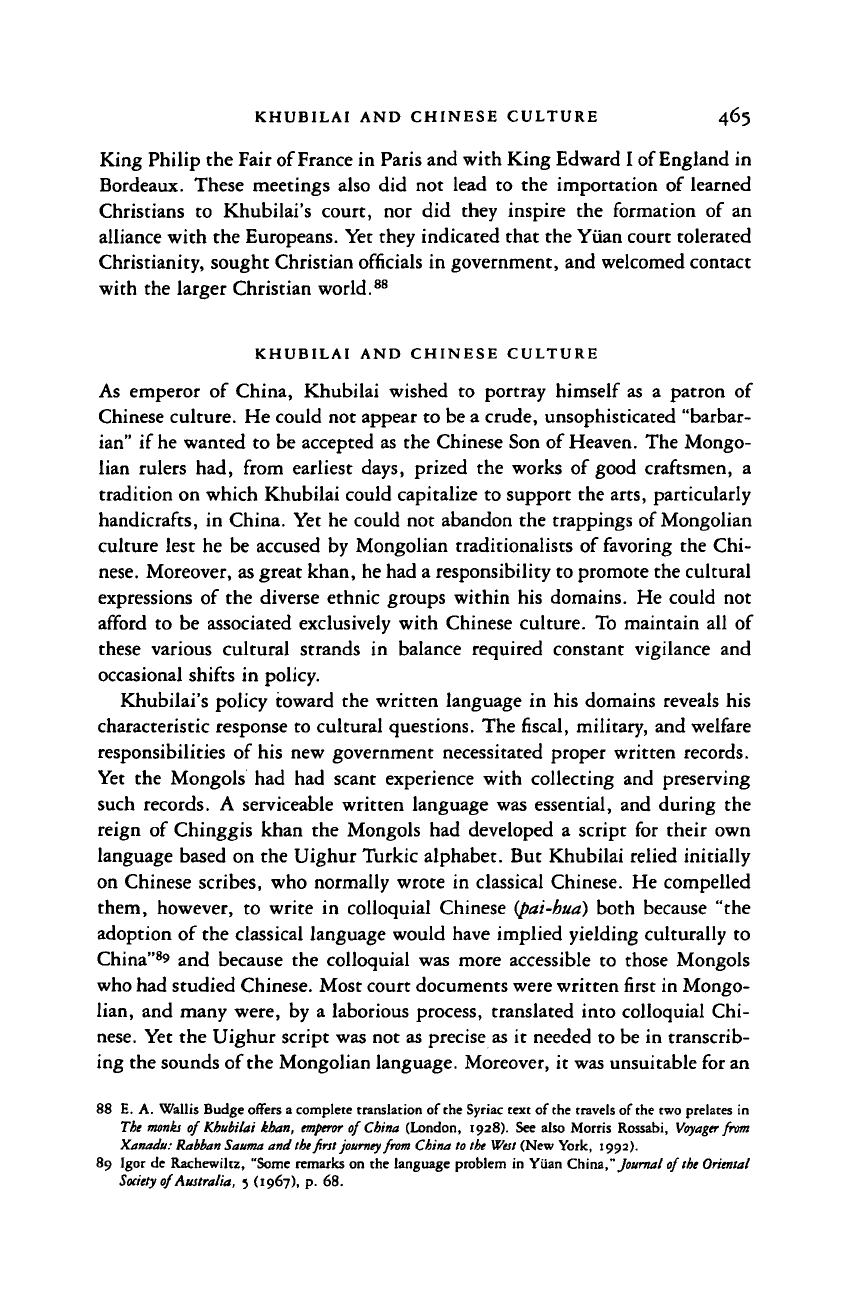
KHUBILAI AND CHINESE CULTURE 465
King Philip the Fair of France in Paris and with King Edward I of England in
Bordeaux. These meetings also did not lead to the importation of learned
Christians to Khubilai's court, nor did they inspire the formation of an
alliance with the Europeans. Yet they indicated that the Yuan court tolerated
Christianity, sought Christian officials in government, and welcomed contact
with the larger Christian world.
88
KHUBILAI AND CHINESE CULTURE
As emperor of China, Khubilai wished to portray himself as a patron of
Chinese culture. He could not appear to be a crude, unsophisticated "barbar-
ian" if he wanted to be accepted as the Chinese Son of Heaven. The Mongo-
lian rulers had, from earliest days, prized the works of good craftsmen, a
tradition on which Khubilai could capitalize to support the arts, particularly
handicrafts, in China. Yet he could not abandon the trappings of Mongolian
culture lest he be accused by Mongolian traditionalists of favoring the Chi-
nese.
Moreover, as great khan, he had a responsibility to promote the cultural
expressions of the diverse ethnic groups within his domains. He could not
afford to be associated exclusively with Chinese culture. To maintain all of
these various cultural strands in balance required constant vigilance and
occasional shifts in policy.
Khubilai's policy toward the written language in his domains reveals his
characteristic response to cultural questions. The fiscal, military, and welfare
responsibilities of his new government necessitated proper written records.
Yet the Mongols had had scant experience with collecting and preserving
such records. A serviceable written language was essential, and during the
reign of Chinggis khan the Mongols had developed a script for their own
language based on the Uighur Turkic alphabet. But Khubilai relied initially
on Chinese scribes, who normally wrote in classical Chinese. He compelled
them, however, to write in colloquial Chinese (pai-hua) both because "the
adoption of the classical language would have implied yielding culturally to
China"*
9
and because the colloquial was more accessible to those Mongols
who had studied Chinese. Most court documents were written first in Mongo-
lian, and many were, by a laborious process, translated into colloquial Chi-
nese.
Yet the Uighur script was not as precise as it needed to be in transcrib-
ing the sounds of the Mongolian language. Moreover, it was unsuitable for an
88 E. A. Wallis Budge offers a complete translation of the Syriac text of the travels of the two prelates in
The
monks
of Khubilai than,
emperor
of China (London, 1928). See also Morris Rossabi,
Voyager
from
Xanadu: Rabban Sauma and the first
journey from
China to the
West
(New York, 1992).
89 Igor de Rachewiltz, "Some remarks on the language problem in Yuan
China,"
Journal of
the
Oriental
Society
of Australia, 5 (1967), p. 68.
Cambridge Histories Online © Cambridge University Press, 2008

466 THE REIGN OF KHUBILAI KHAN
accurate transcription of Chinese and could not fulfill Khubilai's plans for a
widely applied official script.
Khubilai hoped to use the script that he adopted to help unify his realm
and to assert his claim to universal rule. He wanted to go beyond the written
languages, the Chinese characters and the Uighur script, available to him at
that time. As the ruler of a domain in which various ethnic groups resided
and many languages were spoken, Khubilai wanted a script that could be
employed to transcribe all of these diverse languages. He aspired, in short, to
the development of
a
universal script. What he failed to recognize, however,
was that the imposition of
an
unfamiliar written language would not readily
be accepted. An artificially designed script, no matter how accurate or effec-
tive,
would encounter insurmountable difficulties with people attached to a
tradition-laden written language.
Khubilai was nonetheless determined to develop a better and more univer-
sal script. He assigned to the Tibetan 'Phags-pa the task of creating a new
script, and by 1269 the 'Phags-pa lama had submitted a new alphabet
consisting of forty-one letters and based on Tibetan. The 'Phags-pa script,
sometimes referred to as the "squate script" because of
the
square shape of the
letters, was more precise than the Uighur script in its rendering of
the
sounds
of colloquial Mongolian. It also more accurately reflected the sounds of other
languages, including Chinese, in Khubilai's realm. The 'Phags-pa lama al-
phabet appeared ideally suited to transcribe all the languages in Khubilai's
domain, to serve as a universal script, and to contribute to the unification of
the frequently antagonistic peoples under Mongol rule. Khubilai proudly
designated it as the Mongolian script
{Meng-ku tzu)
and eventually referred to
it as the state script
(kuo
tzu).
He ordered that court documents be written in
the state script and founded academies expressly for the propagation of the
new script.'
0
Yet Khubilai's expectations remained unfulfilled, for the script was not
readily adopted. Even his own officials evaded the regulations mandating its
use in court documents. The schools that he had founded in 1269 were also
not as effective as he would have wished. A report in 1272 by one of his
officials indicated that the children and relatives of his Chinese bureaucrats
were not studying the new script. Despite his efforts and repeated admoni-
tions,
the 'Phags-pa alphabet never replaced either the Uighur script or
Chinese characters. Few examples of'Phags-pa writing have survived. A few
inscriptions on seals, coins, paper money, and porcelain and a few edicts and
90 On the new script, see Nicholas Poppe, trans., and John R. Krueger, ed., The
Mongolian monuments
in
'Pbags-pa script (Wiesbaden, 1957); and Nakano, A
phonological
study in the 'Phags-pa lama script.
Cambridge Histories Online © Cambridge University Press, 2008
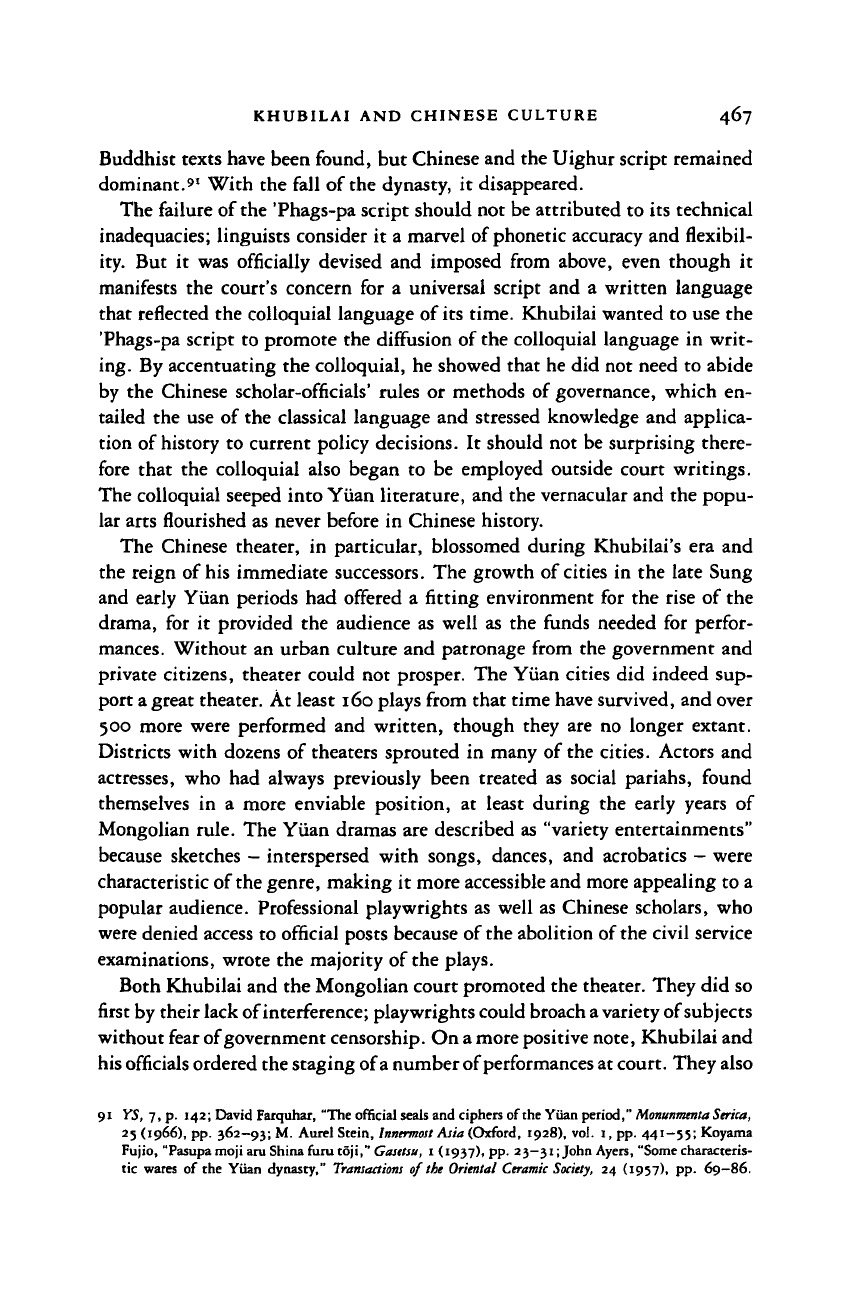
KHUBILAI AND CHINESE CULTURE 467
Buddhist texts have been found, but Chinese and the Uighur script remained
dominant.
91
With the fall of the dynasty,
it
disappeared.
The failure of the 'Phags-pa script should not be attributed to its technical
inadequacies; linguists consider
it
a marvel of phonetic accuracy and flexibil-
ity. But
it
was officially devised and imposed from above, even though
it
manifests the court's concern
for a
universal script and
a
written language
that reflected the colloquial language of its time. Khubilai wanted to use the
'Phags-pa script to promote the diffusion of the colloquial language in writ-
ing. By accentuating the colloquial, he showed that he did not need to abide
by the Chinese scholar-officials' rules
or
methods of governance, which en-
tailed the use of the classical language and stressed knowledge and applica-
tion of history to current policy decisions.
It
should not be surprising there-
fore that the colloquial also began
to
be employed outside court writings.
The colloquial seeped into Yuan literature, and the vernacular and the popu-
lar arts
flourished
as never before in Chinese history.
The Chinese theater,
in
particular, blossomed during Khubilai's era and
the reign of his immediate successors. The growth of cities in the late Sung
and early Yuan periods had offered
a
fitting environment for the rise of the
drama,
for it
provided the audience as well as the funds needed for perfor-
mances. Without an urban culture and patronage from the government and
private citizens, theater could not prosper. The Yuan cities did indeed sup-
port a great theater. At least 160 plays from that time have survived, and over
500 more were performed and written, though they are no longer extant.
Districts with dozens of theaters sprouted in many of the cities. Actors and
actresses, who had always previously been treated as social pariahs, found
themselves
in a
more enviable position,
at
least during the early years
of
Mongolian rule. The Yuan dramas are described as "variety entertainments"
because sketches
-
interspersed with songs, dances, and acrobatics
-
were
characteristic of the genre, making
it
more accessible and more appealing to a
popular audience. Professional playwrights as well as Chinese scholars, who
were denied access to official posts because of
the
abolition of
the
civil service
examinations, wrote the majority of the plays.
Both Khubilai and the Mongolian court promoted the theater. They did so
first by their lack of interference; playwrights could broach
a
variety of subjects
without fear of government censorship. On
a
more positive note, Khubilai and
his officials ordered the staging of
a
number of performances at
court.
They also
91
YS, 7,
p. 142; David Farquhar, "The official seals and ciphers of the Yuan period," Monunmenta Serica,
25 (1966), pp. 362—93; M. Aurel Stein,
Innermost
Asia (Oxford, 1928), vol.
1,
pp. 441—55; Koyama
Fujio,
"Pasupa moji aru Shina furu toji," Gaieiiu, 1 (1937), pp.
23—31;
John Ayers, "Some characteris-
tic wares
of
the Yuan dynasty," Transactions
of
the Oriental Ceramic
Society,
24
(1957),
pp.
69—86.
Cambridge Histories Online © Cambridge University Press, 2008

468 THE REIGN OF KHUBILAI KHAN
appear to have served as patrons for a number of playwrights, and their
espousal of the colloquial facilitated the task of the playwright and contributed
to the development of Yuan
theater.
The Chinese playwrights were responsible
for their own artistic creations. Yet Khubilai and his own Mongolian under-
lings contributed to an environment that encouraged or at the very least did
not undercut the Yuan theater. He knew that a good emperor ought, in
Chinese eyes, to be a patron of
the
country's culture and that the theater, as a
developing art form in China, ought to be supported.
92
Khubilai cannot be given credit for the development of the novel and for
the larger number of printed texts available in China. His cultural and
literary policies nevertheless offered favorable circumstances for growth.
Khubilai's emphasis on the colloquial was a boon to novelists, who often
portrayed characters of a lower-class origin. The use of the vernacular permit-
ted novelists to reproduce the patterns of speech of the ordinary person and to
present a broader range of characters.
The court also promoted the wider diffusion of written texts, as printing
under the Yuan sustained the high standards that had been reached under the
Sung.55 In 1269, Khubilai founded a special office to print books under
official sponsorship, and by 1286, land was assigned to academies, which
used the income to print texts. The growth in printing offered more access to
books and initiated the rise in literacy characteristic of the Ming and Ch'ing
dynasties.
Painting was another aspect of culture affected by the court. Khubilai and
his fellow Mongols found painting accessible, for they did not have to
overcome a formidable language barrier to appreciate it. The khans' own
vanity also made them responsive to visual representations. Khubilai had a
formal portrait of himself painted and then commissioned the artist, Liu
Kuan-tao, to paint him in action during a hunt. He had the Southern Sung's
Imperial Painting Collection transported to Ta-tu, where several Chinese
connoisseurs cataloged it. The Sung paintings provided the foundation for
his own collection, which grew as a result of his patronage of certain artists
and his acquisition of some of their paintings. Some art historians have
emphasized the negative impact, or the lack of influence of Khubilai and the
Mongolian rulers on Chinese painting, but recent interpretations give some
credit to the Yuan court.
94
92 A good study of theater during this time is that by James I. Crump,
Chinese theater
in
the
days ofKublai
khan (Tucson, 1980).
93 K. T. Wu, "Chinese printing under four alien dynasties," Harvard Journal of Asiatic
Studies,
13 (1950),
p.
459; see also Chih-ching (C. T.) Hsia, The
classic
Chinese
novel:
A critical
introduction
(New York,
1968),
p. 8.
94 Sherman E. Lee and Wai-kam Ho, Chinese art under the Mongols: The Yuan dynasty (1279-1368)
(Cleveland, 1968), p. 1.
Cambridge Histories Online © Cambridge University Press, 2008
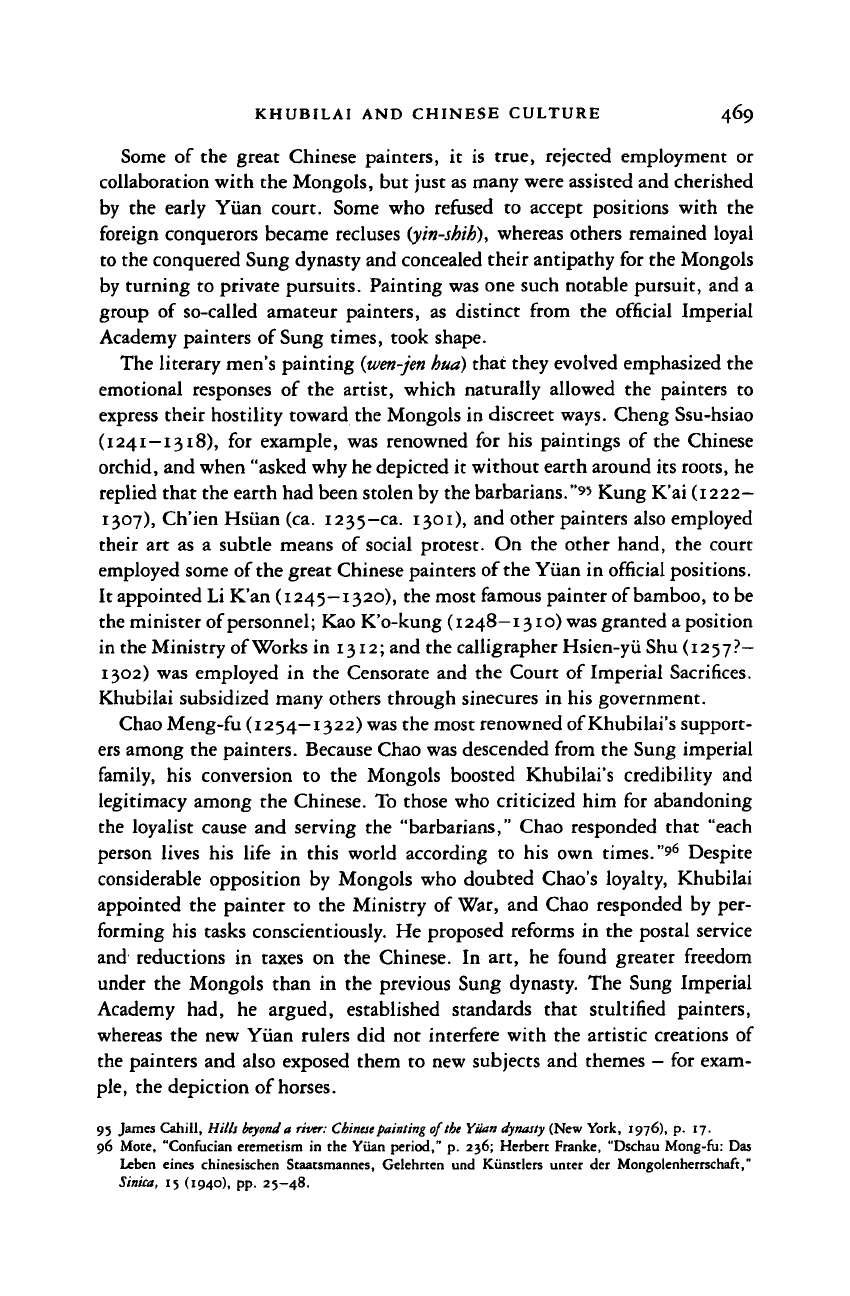
KHUBILAI AND CHINESE CULTURE 469
Some of the great Chinese painters, it is true, rejected employment or
collaboration with the Mongols, but just as many were assisted and cherished
by the early Yiian court. Some who refused to accept positions with the
foreign conquerors became recluses
{yin-shih),
whereas others remained loyal
to the conquered Sung dynasty and concealed their antipathy for the Mongols
by turning to private pursuits. Painting was one such notable pursuit, and a
group of so-called amateur painters, as distinct from the official Imperial
Academy painters of Sung times, took shape.
The literary men's painting
(wen-jen hua)
that they evolved emphasized the
emotional responses of the artist, which naturally allowed the painters to
express their hostility toward the Mongols in discreet ways. Cheng Ssu-hsiao
(1241—1318), for example, was renowned for his paintings of the Chinese
orchid, and when "asked why he depicted it without earth around its roots, he
replied that the earth had been stolen by the barbarians."
9
' Kung K'ai (1222-
1307),
Ch'ien Hsiian (ca. 1235-ca. 1301), and other painters also employed
their art as a subtle means of social protest. On the other hand, the court
employed some of
the
great Chinese painters of the Yiian in official positions.
It appointed Li K'an (1245-1320), the most famous painter of bamboo, to be
the minister of personnel; Kao K'o-kung (1248—1310) was granted a position
in the Ministry of Works in 1312; and the calligrapher Hsien-yii Shu (1257?-
1302) was employed in the Censorate and the Court of Imperial Sacrifices.
Khubilai subsidized many others through sinecures in his government.
Chao Meng-fu (1254-1322)
was
the most renowned of Khubilai's support-
ers among the painters. Because Chao was descended from the Sung imperial
family, his conversion to the Mongols boosted Khubilai's credibility and
legitimacy among the Chinese. To those who criticized him for abandoning
the loyalist cause and serving the "barbarians," Chao responded that "each
person lives his life in this world according to his own times."
96
Despite
considerable opposition by Mongols who doubted Chao's loyalty, Khubilai
appointed the painter to the Ministry of War, and Chao responded by per-
forming his tasks conscientiously. He proposed reforms in the postal service
and reductions in taxes on the Chinese. In art, he found greater freedom
under the Mongols than in the previous Sung dynasty. The Sung Imperial
Academy had, he argued, established standards that stultified painters,
whereas the new Yiian rulers did not interfere with the artistic creations of
the painters and also exposed them to new subjects and themes - for exam-
ple,
the depiction of horses.
95 James Cahill, Hills
beyond
a river:
Chinese
painting of the Yiian dynasty (New York, 1976), p. 17.
96 Mote, "Confucian eremetism in the Yiian period," p. 236; Herbert Franke, "Dschau Mong-fu: Das
Leben eines chinesischen Staatsmannes, Gelehrten und Kiinstlers unter der Mongolenherrschaft,"
Sinica, 15 (1940), pp. 25—48.
Cambridge Histories Online © Cambridge University Press, 2008
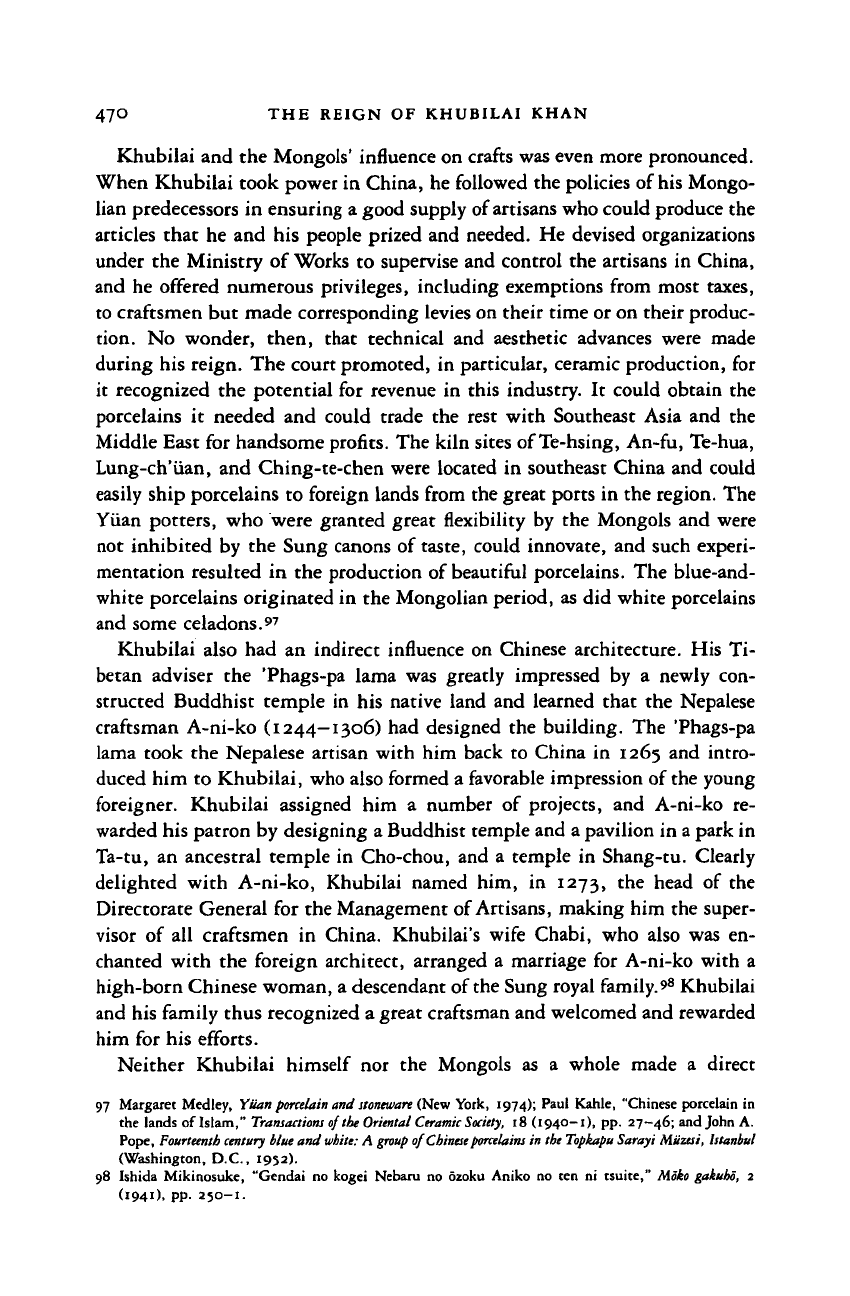
47° THE REIGN OF KHUBILAI KHAN
Khubiiai and the Mongols' influence on crafts was even more pronounced.
When Khubiiai took power in China, he
followed
the policies of
his
Mongo-
lian predecessors in ensuring a good supply of artisans who could produce the
articles that he and his people prized and needed. He devised organizations
under the Ministry of Works to supervise and control the artisans in China,
and he offered numerous privileges, including exemptions from most taxes,
to craftsmen but made corresponding levies on their time or on their produc-
tion. No wonder, then, that technical and aesthetic advances were made
during his reign. The court promoted, in particular, ceramic production, for
it recognized the potential for revenue in this industry. It could obtain the
porcelains it needed and could trade the rest with Southeast Asia and the
Middle East for handsome profits. The kiln sites of Te-hsing, An-fu, Te-hua,
Lung-ch'iian, and Ching-te-chen were located in southeast China and could
easily ship porcelains to foreign lands from the great ports in the region. The
Yuan potters, who were granted great flexibility by the Mongols and were
not inhibited by the Sung canons of taste, could innovate, and such experi-
mentation resulted in the production of beautiful porcelains. The blue-and-
white porcelains originated in the Mongolian period, as did white porcelains
and some celadons.
97
Khubiiai also had an indirect influence on Chinese architecture. His Ti-
betan adviser the 'Phags-pa lama was greatly impressed by a newly con-
structed Buddhist temple in his native land and learned that the Nepalese
craftsman A-ni-ko (1244—1306) had designed the building. The 'Phags-pa
lama took the Nepalese artisan with him back to China in 1265 and intro-
duced him to Khubiiai, who also formed a favorable impression of the young
foreigner. Khubiiai assigned him a number of projects, and A-ni-ko re-
warded his patron by designing a Buddhist temple and a pavilion in
a
park in
Ta-tu, an ancestral temple in Cho-chou, and a temple in Shang-tu. Clearly
delighted with A-ni-ko, Khubiiai named him, in 1273, the head of the
Directorate General for the Management of
Artisans,
making him the super-
visor of all craftsmen in China. Khubilai's wife Chabi, who also was en-
chanted with the foreign architect, arranged a marriage for A-ni-ko with a
high-born Chinese woman, a descendant of
the
Sung royal family.
98
Khubiiai
and his family thus recognized a great craftsman and welcomed and rewarded
him for his efforts.
Neither Khubiiai himself nor the Mongols as a whole made a direct
97 Margaret Medley, Yiian porcelain and
stoneware
(New York, 1974); Paul Kahle, "Chinese porcelain in
the lands of Islam," Transactions
of
tbe Oriental
Ceramic
Society,
18 (1940-1), pp. 27-46; and John A.
Pope,
Fourteenth century
blue and
white:
A
group
of Chinese
porcelains
in the
Topkapu
Sarayi
Mu'zesi,
Istanbul
(Washington, D.C., 1952).
98 Ishida Mikinosuke, "Gendai no kogei Nebaru no ozoku Aniko no ten ni tsuite," Moko gakuho, 2
(1941),
pp.
250-1.
Cambridge Histories Online © Cambridge University Press, 2008
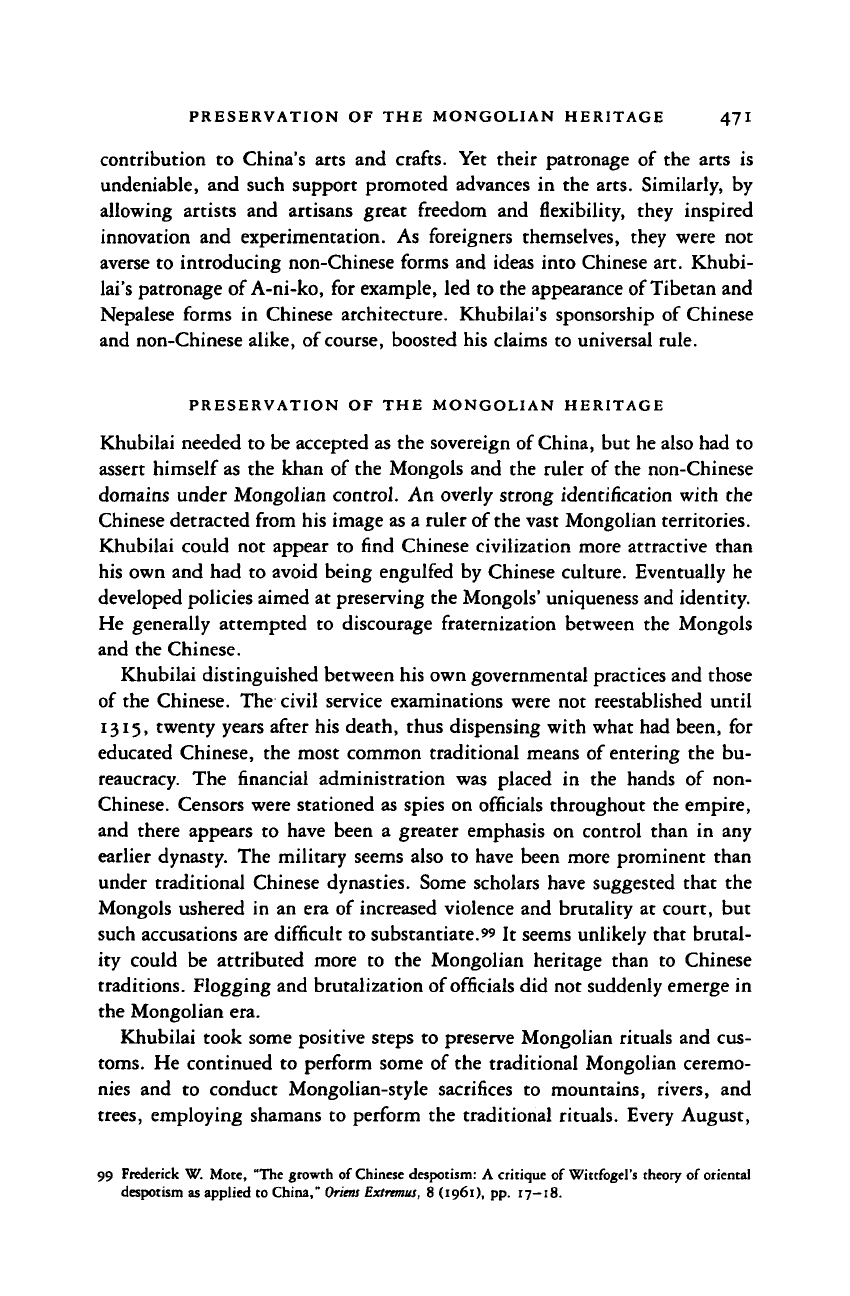
PRESERVATION OF THE MONGOLIAN HERITAGE 471
contribution to China's arts and crafts. Yet their patronage of the arts is
undeniable, and such support promoted advances in the arts. Similarly, by
allowing artists and artisans great freedom and flexibility, they inspired
innovation and experimentation. As foreigners themselves, they were not
averse to introducing non-Chinese forms and ideas into Chinese art. Khubi-
lai's patronage of
A-ni-ko,
for example, led to the appearance of Tibetan and
Nepalese forms in Chinese architecture. Khubilai's sponsorship of Chinese
and non-Chinese alike, of
course,
boosted his claims to universal rule.
PRESERVATION OF THE MONGOLIAN HERITAGE
Khubilai needed to be accepted as the sovereign of
China,
but he also had to
assert himself as the khan of the Mongols and the ruler of the non-Chinese
domains under Mongolian control. An overly strong identification with the
Chinese detracted from his image as a ruler of the vast Mongolian territories.
Khubilai could not appear to find Chinese civilization more attractive than
his own and had to avoid being engulfed by Chinese culture. Eventually he
developed policies aimed at preserving the Mongols' uniqueness and identity.
He generally attempted to discourage fraternization between the Mongols
and the Chinese.
Khubilai distinguished between his own governmental practices and those
of the Chinese. The civil service examinations were not reestablished until
1315,
twenty years after his death, thus dispensing with what had been, for
educated Chinese, the most common traditional means of entering the bu-
reaucracy. The financial administration was placed in the hands of non-
Chinese. Censors were stationed as spies on officials throughout the empire,
and there appears to have been a greater emphasis on control than in any
earlier dynasty. The military seems also to have been more prominent than
under traditional Chinese dynasties. Some scholars have suggested that the
Mongols ushered in an era of increased violence and brutality at court, but
such accusations are difficult to substantiate.^ It seems unlikely that brutal-
ity could be attributed more to the Mongolian heritage than to Chinese
traditions. Flogging and brutalization of officials did not suddenly emerge in
the Mongolian era.
Khubilai took some positive steps to preserve Mongolian rituals and cus-
toms.
He continued to perform some of the traditional Mongolian ceremo-
nies and to conduct Mongolian-style sacrifices to mountains, rivers, and
trees,
employing shamans to perform the traditional rituals. Every August,
99 Frederick W. Mote, "The growth of Chinese despotism: A critique of Wittfogel's theory of oriental
despotism as applied to China,"
Orient
Extremus,
8 (1961), pp. 17-18.
Cambridge Histories Online © Cambridge University Press, 2008
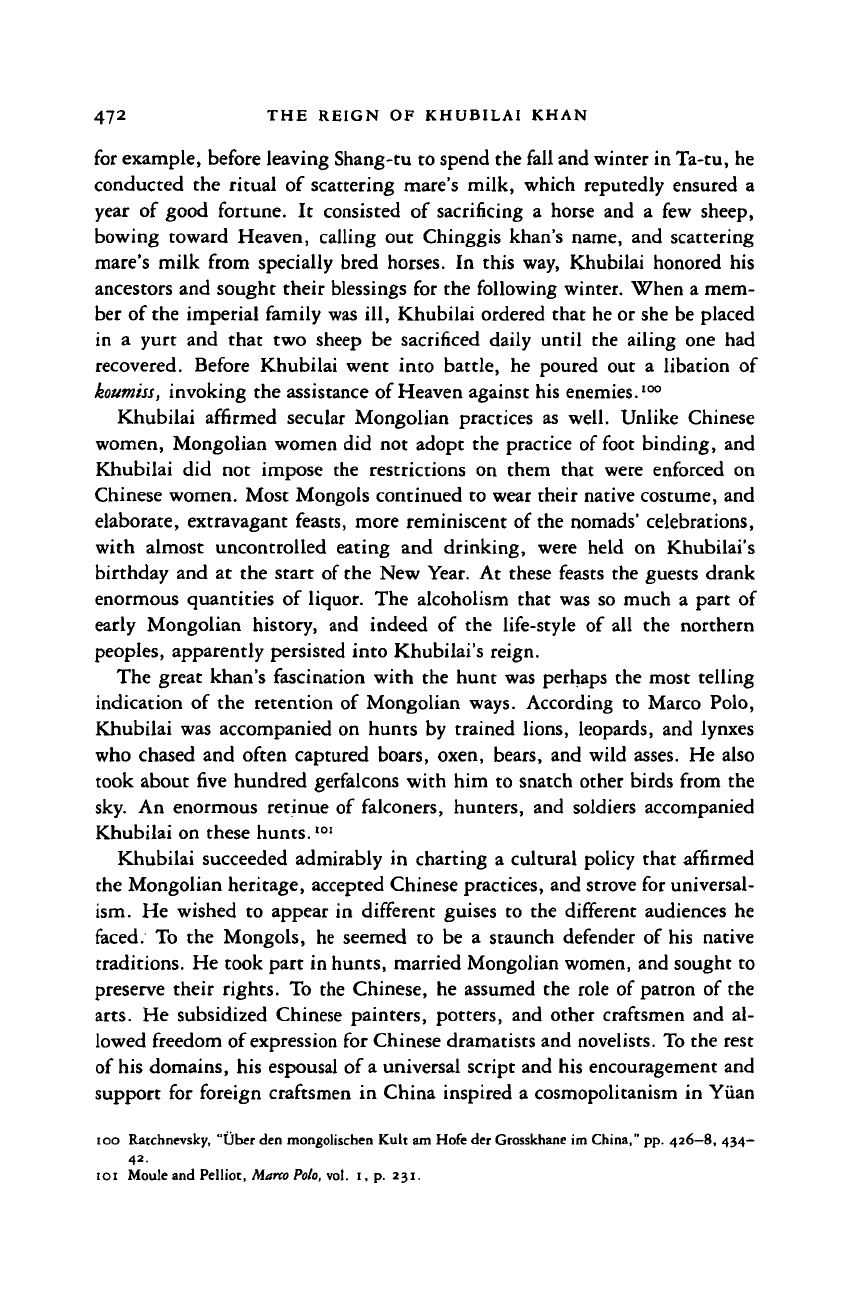
47
2
THE REIGN OF KHUBILAI KHAN
for example, before leaving Shang-tu to spend the fall and winter in Ta-tu, he
conducted the ritual of scattering mare's milk, which reputedly ensured a
year of good fortune. It consisted of sacrificing a horse and a few sheep,
bowing toward Heaven, calling out Chinggis khan's name, and scattering
mare's milk from specially bred horses. In this way, Khubilai honored his
ancestors and sought their blessings for the following winter. When a mem-
ber of the imperial family was ill, Khubilai ordered that he or she be placed
in a yurt and that two sheep be sacrificed daily until the ailing one had
recovered. Before Khubilai went into battle, he poured out a libation of
koumiss,
invoking the assistance of Heaven against his enemies.
100
Khubilai affirmed secular Mongolian practices as well. Unlike Chinese
women, Mongolian women did not adopt the practice of foot binding, and
Khubilai did not impose the restrictions on them that were enforced on
Chinese women. Most Mongols continued to wear their native costume, and
elaborate, extravagant feasts, more reminiscent of the nomads' celebrations,
with almost uncontrolled eating and drinking, were held on Khubilai's
birthday and at the start of the New Year. At these feasts the guests drank
enormous quantities of liquor. The alcoholism that was so much a part of
early Mongolian history, and indeed of the life-style of all the northern
peoples, apparently persisted into Khubilai's reign.
The great khan's fascination with the hunt was perhaps the most telling
indication of the retention of Mongolian ways. According to Marco Polo,
Khubilai was accompanied on hunts by trained lions, leopards, and lynxes
who chased and often captured boars, oxen, bears, and wild asses. He also
took about five hundred gerfalcons with him to snatch other birds from the
sky. An enormous retinue of falconers, hunters, and soldiers accompanied
Khubilai on these hunts.
101
Khubilai succeeded admirably in charting a cultural policy that affirmed
the Mongolian heritage, accepted Chinese practices, and strove for universal-
ism. He wished to appear in different guises to the different audiences he
faced. To the Mongols, he seemed to be a staunch defender of his native
traditions. He took part in hunts, married Mongolian women, and sought to
preserve their rights. To the Chinese, he assumed the role of patron of the
arts.
He subsidized Chinese painters, potters, and other craftsmen and al-
lowed freedom of expression for Chinese dramatists and novelists. To the rest
of his domains, his espousal of a universal script and his encouragement and
support for foreign craftsmen in China inspired a cosmopolitanism in Yuan
100
Ratchnevsky,
"fiber
den
mongolischen Kult
am
Hofe
der
Grosskhane
im
China,"
pp.
426—8,
434—
42-
101
Moule
and
Pelliot,
Marco
Polo,
vol. 1, p. 231.
Cambridge Histories Online © Cambridge University Press, 2008
